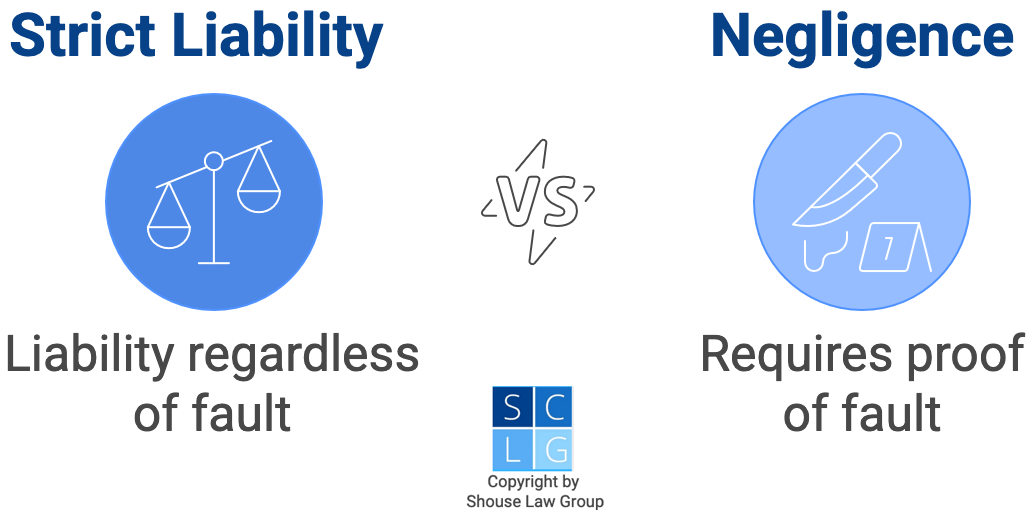
In negligence cases, you have to show that the defendant was at fault because he or she acted without due care or breached a duty of care. In strict liability cases, you only have to show that the defendant caused your injuries – not that he or she acted in any sort of deficient manner.

How do I win a negligence case?
To win a negligence case, you have to prove 4 things:
- the defendant owed you a duty of care,
- he or she breached that duty of care,
- that breach caused your injuries, and
- you were, in fact, hurt.1
To recover compensation for a plaintiff’s injuries under a theory of negligence, a personal injury lawyer has to prove all of these elements by a preponderance of the evidence.
Duty of care
Generally, the duty of care is to act as a reasonably prudent person would act in similar situations. Some examples are:
- motorists have to use due care to drive reasonably safely and obey traffic laws to avoid car accidents,
- property owners have to take reasonable precautions to keep visitors safe, or face premises liability, and
- employers must take reasonable care not to hire someone negligently who would put customers in unsafe situations.
There are exceptions to this duty of care, though. For example:
- children may be held to a lower amount of care, or even no duty of care at all, and
- medical professionals, like doctors and surgeons, can be held to a higher level of care in medical malpractice cases.
If the defendant had no duty of care towards you, they cannot face tort liability under the negligence rule.
Breach of the duty of care
Once you have established the standard of care, you have to show that the defendant breached it. Showing there was a breach of duty can be a very factually intensive process however, if the defendant violated a statute, like a traffic law, that can be used as proof that he or she was negligent per se because a reasonable person always abides by them.
Causation
If you can show that the defendant breached their duty of care, you must show that the breach caused your injuries. Causation has 2 elements:
- actual cause, sometimes referred to as cause-in-fact, and
- proximate cause, also referred to as legal cause.
Actual cause looks to whether the defendant’s conduct was connected at all to your injuries. It generally uses the “but-for” test. This test asks the following question:
“But-for the defendant’s conduct, would you have gotten hurt?”
If the answer is “no,” the defendant’s breach was the actual cause. If the answer is “yes,” the defendant’s conduct was not the actual cause because you would have gotten hurt, anyway.
Proximate cause looks to whether the defendant’s conduct, if proven to be the actual cause of your injuries, was nevertheless too remote to hold them liable. Several tests can be used to determine proximate cause.
One of them is the substantial factor test. If the defendant’s conduct was a substantial factor in your injuries, proximate cause is satisfied.2 Because there can be more than one substantial factor that caused your injuries,3 this test is often used when there are multiple defendants or tortfeasors.
Another common test is foreseeability. If your injuries were a foreseeable outcome of the defendant’s conduct, that conduct was the proximate cause of the injuries. The defendant can then be held liable for them.
You were hurt
If you can show that there was a duty of care, that it was breached, and that it caused your injuries, you then have to show the extent of your losses. This is not confined to the costs of your medical treatment. It includes all of the losses that the defendant’s negligence causes, like:
- medical bills,
- lost wages and other income,
- lost earning capacity if the injuries will keep you from working in the future,
- pain and suffering,
- property damage, and
- loss of consortium for your family members and loved ones.
A personal injury attorney can help you prove the true extent of your losses.
What are some examples of these cases?
Most personal injury cases are based on negligence. A few examples of negligence include:
- motor vehicle accidents, including truck accidents, motorcycle accidents, and pedestrian accidents,
- medical malpractice,
- slip and fall cases, and
- wrongful death.
Some cases, like product liability or dog bite claims, can be based on either negligence or on strict liability.
How do I win a case based on strict liability?
Under tort law, strict liability is liability without fault. The defendant pays for the costs of the accident even though the defendant was not at fault for it. You do not have to prove that there was a duty of care and a breach of it that caused your injuries. This makes a case based on strict much easier to win.
What are some examples of these tort cases?
One example of a strict liability lawsuit is a dog bite case, though not all jurisdictions use the rule of strict liability for these claims. In those that do, however, if a dog bites someone, the owner is liable for the injuries.4 This is the case, even if the owner:
- did everything he or she could to control the dog, and
- had no way of knowing that the dog was dangerous.
There are, however, certain exceptions to this rule. There is not strict liability if:
- the victim was trespassing,
- the dog was a law enforcement canine,
- the defendant was not the dog owner, such as if someone other than the owner was taking care of the dog at the time of the attack,
- the victim assumed the risk of the bite, like if he or she was a kennel worker or a veterinarian, or
- the victim was partially at fault, often because they provoked the dog.
In these cases, though, the dog bite can still proceed based on the defendant’s negligence.
Other examples of personal injury cases based on strict liability are causes of action for:
- injuries caused by dangerous, wild, or exotic animals,
- injuries caused by abnormally dangerous activities,
- vicarious liability, which holds an employer strictly liable for injuries caused by its employee’s negligence, and
- products liability.
Like dog bites, products liability cases can proceed based on either strict liability or negligence. If the case is based on strict liability, you generally only have to prove that you were using the defective product in a reasonable way and that a defect in the product’s caused your injuries:
- design,
- manufacture, or
- warnings.5
Filing a case of strict product liability before the statute of limitations has expired often takes the help of a personal injury lawyer from a reputable law firm.
Legal References:
- See California Civil Jury Instructions (CACI) No. 400.
- Wisniewski v. Great Atlantic and Pacific Tea Co., 323 A.2d 744 (1974).
- CACI No. 431.
- See California Civil Code 3342.
- See Soule v. GM Corp., 8 Cal.4th 548 (1994).

